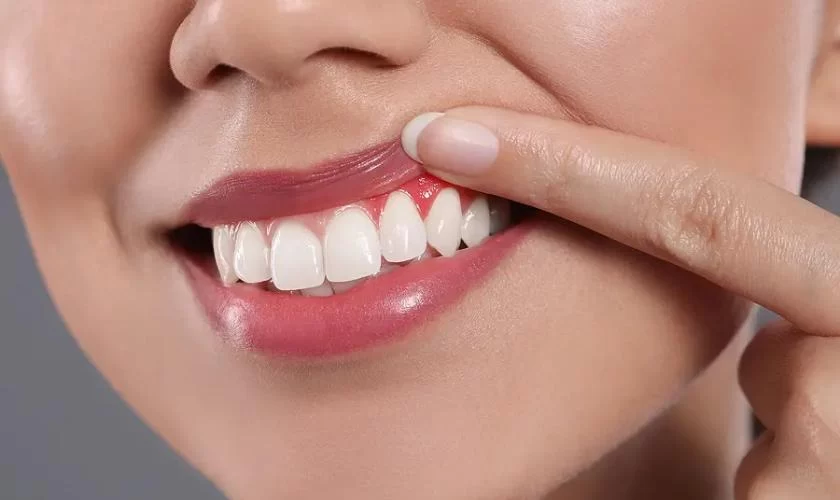
- Understanding-Gum-Recession
- Early-Signs-and-Causes-of-Gum-Recession
- Non-Surgical-Approaches-to-Treating-Gum-Recession
- Advanced-Gum-Recession-Treatment-Options
- Preventive-Care-and-Maintenance-for-Gum-Health
1. Understanding Gum Recession and Its Impact
Gum recession is a dental condition where the gum tissue surrounding the teeth gradually pulls back, exposing more of the tooth or its root. This not only affects the aesthetics of your smile but also increases sensitivity and vulnerability to decay and infections. Many adults face gum recession, often unaware of its early signs or the importance of timely treatment.
From a personal perspective, gum recession can be distressing. For example, John, a 38-year-old teacher, noticed his teeth appeared longer and experienced sharp sensitivity while drinking cold beverages. After a visit to his dentist, he was diagnosed with early-stage gum recession. His story is a common reminder that understanding how to treat gum recession early can save teeth and prevent further complications.
Effective treatment is a combination of professional dental care and diligent home practices. By exploring both, you can protect your oral health and retain a confident, healthy smile.
2. Early Signs and Causes of Gum Recession
Recognizing the initial symptoms of gum recession is crucial for timely intervention. Key signs include increased tooth sensitivity, visibly longer teeth, and gum inflammation. Sometimes, bleeding during brushing or flossing can also signal that the gums are weakening.
2.1 Common Causes
Understanding the root causes helps in both treatment and prevention. The most frequent contributors include:
- Aggressive brushing: Using hard-bristled toothbrushes or harsh brushing techniques can damage gums.
- Periodontal disease: Infection of the gums leads to tissue destruction and recession.
- Genetics: Some individuals have naturally thinner gums, making them prone to recession.
- Hormonal changes: Fluctuations during pregnancy or menopause can increase gum sensitivity.
- Poor dental hygiene: Plaque buildup encourages gum inflammation and recession.
- Other factors: Tobacco use, teeth grinding, misaligned bite, or piercings can also contribute.
3. Non-Surgical Approaches to Treating Gum Recession
When caught early, gum recession can often be managed effectively without surgery. These approaches focus on halting progression and promoting gum health.
3.1 Improved Oral Hygiene Practices
Switching to a soft-bristled toothbrush and adopting gentle brushing techniques are fundamental. Flossing carefully and using antiseptic mouthwash can reduce plaque and soothe inflamed gums.
3.2 Professional Cleaning and Scaling
Regular dental cleanings remove plaque and tartar, which contribute to gum disease. In some cases, dentists perform deep cleaning procedures like scaling and root planing to clean infected gum pockets, helping gums reattach to teeth.
3.3 Desensitizing Agents and Protective Pastes
Products designed for sensitive teeth can relieve discomfort caused by exposed roots. Your dentist might recommend fluoride treatments or special toothpaste to strengthen enamel and reduce sensitivity.
4. Advanced Gum Recession Treatment Options
In cases where recession is more severe, surgical interventions may be necessary to restore gum tissue and protect tooth roots.
4.1 Gum Grafting Procedures
Gum grafting involves transplanting tissue from the roof of the mouth or a donor source to cover exposed roots. This procedure reduces sensitivity, improves appearance, and protects teeth from further damage. Advances in techniques have made grafting more comfortable and effective.
4.2 Pinhole Surgical Technique (PST)
PST is a minimally invasive procedure that repositions existing gum tissue to cover exposed areas without traditional grafts. It offers quicker recovery times and less discomfort.
4.3 Regenerative Procedures
In some situations, regenerative materials like enamel matrix proteins or bone grafts help stimulate tissue growth and restore gum health.
When considering these advanced options, consulting with a dental professional is essential. Dentistry Toothtruth offers expert advice and access to specialized treatments tailored to individual needs, helping patients choose the best approach for their gum health.
5. Preventive Care and Maintenance for Long-Term Gum Health
Treating gum recession is only part of the journey; maintaining gum health requires ongoing care and lifestyle adjustments.
5.1 Regular Dental Checkups
Frequent dental visits ensure early detection of gum recession and timely intervention. Professional cleanings help prevent plaque buildup that leads to recession.
5.2 Lifestyle Modifications
Quitting smoking and managing stress to reduce teeth grinding play a significant role in gum preservation. A balanced diet rich in vitamins C and D supports gum tissue health.
5.3 Personalized Oral Care Products
Choosing toothpaste, mouthwash, and toothbrushes designed for sensitive gums can protect vulnerable areas and improve comfort. Dentistry Toothtruth can guide you to products that fit your specific oral health needs.
By combining early recognition, effective treatment strategies, and consistent preventive care, you can successfully manage gum recession. Taking control of your oral health today ensures a healthier smile tomorrow.







 Summit Dental Care4.0 (124 review)
Summit Dental Care4.0 (124 review) Fair Oaks Orthodontics5.0 (29 review)
Fair Oaks Orthodontics5.0 (29 review) Dental Care of North Fort Myers4.0 (708 review)
Dental Care of North Fort Myers4.0 (708 review) Sarkissian Dentistry: Robert Sarkissian, DDS, MAGD5.0 (84 review)
Sarkissian Dentistry: Robert Sarkissian, DDS, MAGD5.0 (84 review) Root 66 Endodontics4.0 (16 review)
Root 66 Endodontics4.0 (16 review) Scott Soderquist, DDS, MS0.0 (0 review)
Scott Soderquist, DDS, MS0.0 (0 review) The Importance of Oral Health Education During Pregnancy for a Healthy Pregnancy
The Importance of Oral Health Education During Pregnancy for a Healthy Pregnancy Best Tips for Brushing Your Teeth Properly for Healthy Gums: Essential Techniques for Oral Health
Best Tips for Brushing Your Teeth Properly for Healthy Gums: Essential Techniques for Oral Health Why Skipping Dental Checkups Can Lead to Bigger Oral Health Problems
Why Skipping Dental Checkups Can Lead to Bigger Oral Health Problems Advantages of Porcelain Dental Restorations
Advantages of Porcelain Dental Restorations How Can Diabetes Cause Tooth and Gum Problems? Preventing and Managing Oral Health Issues
How Can Diabetes Cause Tooth and Gum Problems? Preventing and Managing Oral Health Issues Healthy Habits for Promoting Good Oral Health and Hygiene: Tips for a Healthy Smile
Healthy Habits for Promoting Good Oral Health and Hygiene: Tips for a Healthy Smile